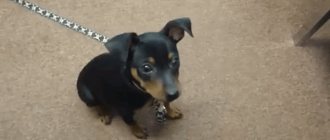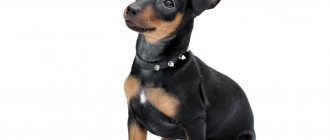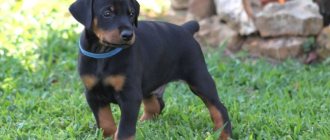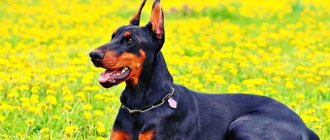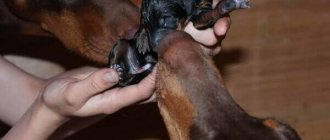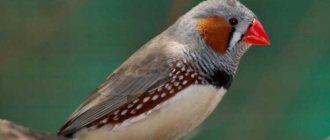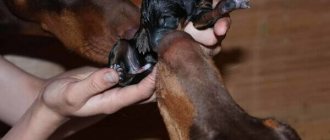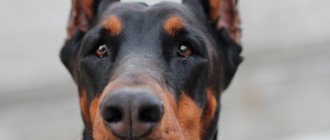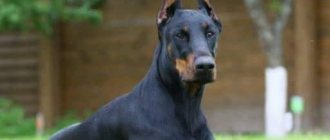| Aggressiveness |
| Upbringing |
| Training |
| Intelligence |
| Shedding |
| Behavior with children |
| Watchman |
| Security guard |
| Difficult to care for |
| Endurance in the cold |
| Endurance in the heat |
| Germany | |
| Lifespan | 12−15 years |
| Height male | 66–71 cm |
| Rising bitch | 61–66 cm |
| Weight male | 30-40 kg |
| Weight bitch | 30–40 kg |
The Doberman is a dog named after its creator. There are not many breeds in the world that owe their great name to specific individuals who took part in their formation. You can remember the Jack Russell Terrier, Gordon Setter, Hamilton Hound, Dunker. Doberman is one of them.
If we compare the Doberman with other animals, it has the elegance, stature, grace, quick reaction and strength that are inherent in purebred horses. He is a "super working" dog and has earned an impeccable reputation in police, security, patrol and military service.
Dogs trained for professional activities, during the existence of the breed, were awarded many epithets: “the devil’s dog”, “a loaded pistol”, a dog of the color of “anthracite and death”. But the Rni are not as aggressive as many people think. The breed is only suitable for a trained owner who knows how to raise a Doberman, and whose pet will never become a ferocious, dangerous dog.
The Dobermann belongs to group 2 “Pinchers, Schnauzers, Molossians and Swiss Cattle Dogs” in the ICF classification, section 1 “Pinchers and Schnauzers”.
Origin story
The origin story is somewhat vague. The breeding of the Doberman Pinscher dog breed was carried out by a versatile public figure - Friedrich Louis Dobermann. He needed a companion who could perform police functions.
Friedrich Dobermann did not keep complete records of the breeding process. The roots of this breed are revealed only by logic and knowledge of those breeds that were common in Germany. It has been established that Doberman began breeding a new breed in the 1880s; experts can only guess about the ancestors of the breed. They agree that the following were used to develop the Doberman Pinscher breed:
- Ancestors of the Old German Pinschers;
- Herding dogs – shepherd dogs;
- Butcher dogs;
- Hunting shorthaired pointers.
It is believed that the Doberman breed crossed paths with the Manchester Black and Tan Terriers, Blue Great Danes, Mastiffs and others.
Photo
Meet the Doberman breed, photos of which are presented in the gallery above. Not a single dog photo turns out bad. It’s as if the Doberman has been studying the art of posing all his life, because in every photo he looks graceful, dignified and elegant.
Interesting facts about the breed:
In Russia, the Doberman was very popular in the 20-40s, it was used as a security guard, demolition worker, sapper, reconnaissance officer, and paratrooper. Gradually, the dog lost its position to the German Shepherd, and all because there were not enough dog handlers in the country capable of training this unique breed.
Not only the Greyhound, St. Bernard, Husky, Tibetan Mastiff, Afghan Hound, but also the Doberman Pinscher appeared in the Guinness Book of Records. He is recognized as the best bloodhound, because a dog named Sauer from South Africa at the beginning of the 20th century was able to track down a thief, despite a distance of 160 km.
Doberman breed standards
This fearless, ferocious breed has inherited the positive genetic qualities of its ancestors. She is resilient, endowed with quick reactions and an inexhaustible supply of energy.
Size and appearance
These are medium sized dogs.
Height of males: 68.5 – 72 cm at the withers, females: 63 – 68 cm.
The weight of adult males is 43 kg, females – 34 kg.
Brief characteristics of Dobermans:
- The head looks like a blunt wedge when viewed from above;
- Flat forehead;
- Deep muzzle;
- Tight lips;
- White teeth with a scissor bite;
- Eyes of medium size, dark colors;
- Highly set muscular neck;
- High withers;
- Short and strong back;
- Oval chest;
- Muscular forelimbs with straight forearms;
- Wide muscular thighs;
- Short, harsh coat;
- The color of the Doberman is black or dark brown and tan.
Lifespan
The idea that animals will not live very long is unfounded. Life expectancy is from 12 to 15 years.
Proper housing conditions, a balanced diet, and healthy genetics allow Dobermans to live a long life in an apartment or house.
The lifespan of a Doberman depends on:
- Proper care. The dog should live in a warm apartment, constantly experience physical activity and often walk in the fresh air.
- Healthy food. The life expectancy of a Doberman depends on the quality of food. The dog needs a vitamin course.
- Genetics. Diseases from which a particular dog's ancestors suffered can significantly shorten the dog's life.
Character
By temperament the dog is choleric. She is lively, attentive, active and balanced. However, in cases where the owner is in real danger, he can behave unpredictably.
These animals are distinguished by their distrust of strangers; they can grumble and bare their teeth at strangers who come into the house. However, this aggressive behavior quickly fades away after the first command from the owner of a dog that has undergone proper training.
Attitude towards others
These animals are affectionate and loving. You shouldn’t meet them “by their clothes.” They love to communicate with family members and participate in family activities.
Dobermans choose one family member to whom they begin to obey unquestioningly, but sometimes they can show attempts to dominate, which are important to immediately stop.
The Doberman lives in his own home, his own family, drives his own car, and feels like a member of the human pack. This possessive attitude towards everything makes dogs good guards.
They are reserved towards strangers, but are wary. Without provocation, they do not begin to behave aggressively. They are sensitive and behave warily in the presence of strangers, so it is difficult to take them by surprise and cause harm to the owner of a Doberman dog.
Attitude towards children
Animals treat children well, feel their defenselessness and responsibility for preserving the health and life of their family member. This quality makes it possible not to worry about the child if he is left alone with such a dog.
Additional training will teach him to completely ignore the unpleasant physical sensations that a child can cause.
But leaving him alone with a child who is playing with a stranger is not a good idea. If the child cries, the Doberman will perceive this as aggressive behavior of a stranger and will begin to protect the baby.
Intelligence
In various ratings of the intellectual abilities of dog breeds, they occupy the top lines. They have a lively mind, are easy to train, and commands given by the owner are executed with lightning speed and precision.
Education and training
Representatives of this breed are amenable to education and training. This is due to his sharp mind and developed sense of belonging to the family. Raising and training such a dog is simple; it enthusiastically follows commands to please its current owner (breeder or immediate owner).
Dobermans, deprived of educational influence and training, become simply uncontrollable and even somewhat stupid. In life, the Doberman needs constant physical and mental stress.
The first year of life is important in raising a Doberman. At this time, the dog decides on the choice of a leader, a leader who will make him feel safe and comfortable. She will begin to fight for leadership in the family and if she wins, then the family members and she will lose. The Doberman needs an owner whose commands he will carry out precisely and unquestioningly.
Basic rules in raising a Doberman:
- Persistence. Having given any command, you need to ensure that the puppy carries it out.
- Consistency in requirements. If, for example, you used to feed the puppy from the table and then decided to stop. At all. Even if he piteously asks, you cannot give him even a little food. This will not become a positive reinforcement. This is not “gradualism.” The puppy’s perception of the word no will simply be disrupted: no, this is no, but if you ask strongly, then yes.
- Patience. Having explained to the puppy what to do and what not to do and not getting the desired result, you need to patiently repeat the demands and prohibitions until you achieve them.
- Logic and consistency. (Not to be confused with consistency in requirements!) This logic should not be from the point of view of a person, but from the point of view of a puppy. You can't punish him for chewing furniture when you weren't home. Or punish him later. He simply will not understand this relationship. It is necessary to give a reaction directly during the animal’s actions.
- Emotional contact. The owner should not become a person who teaches, feeds, encourages, punishes. The puppy should be interested in the person, the person should become a friend for him.
Only positive motivation is the way to achieve results.
During training, you cannot constantly put pressure on the animal. This causes conflicts. If a dog does something wrong, then you need to correct it; if it does everything right, you need to praise it.
The Doberman is a very sensitive breed and a simple change in intonation can indicate that he is doing something wrong. Ignoring a Doberman becomes the most severe punishment for him for the greatest offenses. When working with your dog, you should also consider rest time.
The sharp mind of a Doberman is both a blessing and a punishment for the owner. The pet will easily identify moments of disobedience that can get away with it.
Doberman Health and Diseases
Dobermanns are endowed with good health, but they are not without breed defects:
- Allergy. The most common allergic reactions in dogs of this breed occur to dust, pollen and mold.
- Heart diseases. Disturbances in the functioning of the cardiovascular system are not uncommon in these pets. If you find difficulty breathing, trembling, loss of balance, you should contact a veterinarian, because serious heart diseases such as heart failure, arrhythmia, etc. can develop in a very young dog under the age of 5 years.
- Hereditary diseases. An animal often “gets” a bad heart, narcolepsy, gastric torsion and hypothyroidism by inheritance. To identify such diseases, annual examinations by a veterinarian and a sensitive attitude to the pet’s health are necessary.
These are common diseases of the breed. But a dog can also suffer from other diseases inherent in representatives of its kind. Having it regularly examined by specialists and getting all the necessary vaccinations means raising a strong animal.
It is also worth noting that the dog is an albino, unlike its brown and black relatives, it suffers from:
- Photophobia;
- Dermatitis;
- Baldness;
- Cancer.
Therefore, if you decide to get a white Doberman, prepare for the problems that will arise with his health.
What to do if your weight is below normal?
If the puppy’s weight is below normal, first of all, you should understand the reasons.
Possible reasons:
- Weaning from mother . This is a serious test and stress for every puppy. In the first month after weaning and transfer to new owners, the baby may not only stop gaining weight, but even lose it. In order to avoid this, babies are given calcined cottage cheese with yolk and liquid vitamins (dosage should be checked with a veterinarian). If the mixture is thick, dilute it with milk.
- Worms are also a very common cause of weight loss . As a rule, the first time anthelmintic is given to a baby at 2 months of age, but if there is a suspicion of the presence of parasites, then the anthelmintic can be given earlier. Before you start, you need to visit a veterinarian and identify the type of worms. After this, the doctor will prescribe one drug or another, taking into account the age and weight of the baby.
- Nutrition - if the baby is stunted, but does not suffer from any disease, pay attention to his nutrition. Include vitamins, nutritional supplements or vitamin-mineral complexes in your puppy's diet.
IMPORTANT!
A normally developing puppy in the third month of life should increase in height by approximately 2 times.
Care and maintenance
Keeping a Doberman comes down to the golden mean between constant physical activity and rest. You shouldn’t let your dog lie down on the sofa, but you shouldn’t overtire him either. She needs regular active walks and physical activity.
The short hair of the Doberman and his natural dislike of cold and damp require understanding and action from the owner. In rainy times, the dog needs a raincoat, when the thermometer drops below -10 degrees, insulated overalls, and in severe frosts, shoes are also needed. A dog with cropped ears needs a hat.
You must not allow your dog to get frostbite. This can lead to seasonal otitis media.
Grooming is simple. For a short-haired dog, it is enough to brush it once a week and wipe it with a damp towel. During shedding, it is necessary to comb it at least 3 times a week.
Disease susceptibility
In general, Dobermans are in good health. The most common pathology is dilated cardiomyopathy and heart rhythm disturbances; elbow dysplasia, osteopathy, coagulopathy, Wobbler syndrome, hypothyroidism, and epilepsy are also common.
Due to their high mobility, Dobermans are susceptible to musculoskeletal injuries, cut and puncture wounds. In adult Dobermans, gastric volvulus and cancer occur.
It is important to remember that compliance with the conditions for keeping the Doberman, as well as preventive veterinary examinations from an early age, prevent the development of many diseases.
Advantages and disadvantages
Characteristics of the breed. Advantages:
- Wide range of applications from household to search and rescue;
- Unquestioning loyalty. With its owner, the Doberman will go through fire, water, copper pipes and any other tests;
- A high level of intelligence makes it easy to raise and train an animal. It perceives education and learning as a pleasant pastime. (If you approach it wisely);
- A strong, healthy dog with a fairly long life.
Characteristics of the breed. Flaws:
- The owner must be a strong-willed and strong person for the dog to obey him unquestioningly;
- Waywardness. A high level of intelligence is both a reward and a punishment. The animal has its own point of view on everything. A minor gap in upbringing can ruin your nerves;
- An animal can be aggressive and pugnacious if its upbringing was incorrect;
- He needs physical and mental exercise, and not simple walks in the park;
- The Doberman's diet must be balanced, correct, satisfy its energy needs, and promote the development of muscle mass.
Therefore, such an animal must be owned by a strong, self-confident person who is ready to take responsibility for raising and training. Otherwise, all the advantages of the breed will be distorted and turned into ugly flaws, making the dog a disobedient, annoying and dangerous animal.
Feeding recommendations
Due to their body type and activity level, Doberman Pinschers are not suitable for the daily diet of regular dogs.
Athletic build and high activity require increased energy expenditure and, accordingly, a diet high in calories. These conditions are met by Purina® PRO PLAN® Large Puppy Athletic complete dry food for large breed puppies with an athletic build, and for adult dogs - Purina® PRO PLAN® Large Adult Athletic food with the OPTIBALANCE® complex. This food not only provides the dog’s body with the necessary energy, but also supports the health of the dental system, joints and helps improve digestion. Publication on our Yandex Zen channel
How to choose a Doberman puppy
You can't match a Doberman Pinscher from a photo. Owning such a dog requires a balanced approach. It’s not enough to read books and be confident that you can cope with an animal. You need to choose a healthy, full of life puppy, ready for training and training.
First, look at your mother. If, when she sees you, she begins to behave aggressively and does not respond to the owner’s commands, this is the first “bell”. Excuses like “she’s protecting the puppy” are ridiculous. A dog of this breed must unquestioningly obey its owner, and after one and a half to two months it will already be pretty tired of its litter, and will not “tear and throw” in order to protect it against the will of the owner. This behavior may indicate insufficient training of the dog or mental problems. You can't guess anymore. Its appearance should be healthy: shiny coat, lively eyes, even breathing without wheezing and no discharge from the eyes. The same applies to the puppy.
The puppy should not have visible ribs or, on the contrary, a bloated belly. He must be active and inquisitive. The opposite behavior of the puppy is another “bell” about problems with the animal’s health.
Visit several nurseries and choose the most beautiful, active and healthy puppy in your opinion. The price of a puppy in nurseries or from breeders may vary. It all depends on the purposes for which you take it. The most expensive puppies will be champions, who will continue the glorious exploits of their ancestors. However, when purchasing them, you should verify the authenticity of all documents. Dogs not for show will cost several times less.
Similar breeds
| Tibetan mastiff | Beauceron | Cane Corso |
Prices
How much does a Doberman cost? The cost of puppies depends on their class, the pricing policy of the nursery and the geographical location of the breeder. Through private advertisements, you can buy a Doberman for an average of 8 thousand rubles; the availability of documents for the puppy, of course, is out of the question.
Despite the large number of nurseries and the popularity of the Doberman breed, the price for them is quite high. If you decide to purchase a puppy with all the necessary documentation, you will have to focus on price tags from 15 to 50 thousand rubles.
Pet-class puppies, not allowed for breeding, and for some reason unable to participate in exhibitions, cost from 15 to 23 thousand rubles.
Representatives of the breeding class, who are predicted to have a breeding and exhibition future, cost from 24 to 35 thousand rubles. Show class can be purchased for a price of more than 35 thousand rubles.
Watch a video about the breed
Owning a Doberman is a serious step, which must be taken with a full understanding of the responsibility that rests with you for the life and health of the animal, responsibility for its wayward behavior, proper upbringing and training.
If you do everything correctly, approach all issues wisely, you will get a faithful and obedient friend who will live happily ever after in your family. In another case, you can get an aggressive animal, which can be dangerous both for the owner (whom it does not consider the owner) and for society.
Temperament (psychology)
Balanced, strong. Can handle both security and safe everyday household roles equally. For example, after minor training, you can safely leave it with small children, who in turn, consciously or unconsciously, can use various kinds of stimuli to which the dog responds adequately.
Sources:
https://pikabu.ru/story/doberman_1736627 https://alldogs.info/%D0%B4%D0%BE%D0%B1%D0%B5%D1%80%D0%BC%D0%B0%D0% BD-3/ https://wikipedia.green/%D0%94%D0%BE%D0%B1%D0%B5%D1%80%D0%BC%D0%B0%D0%BD
